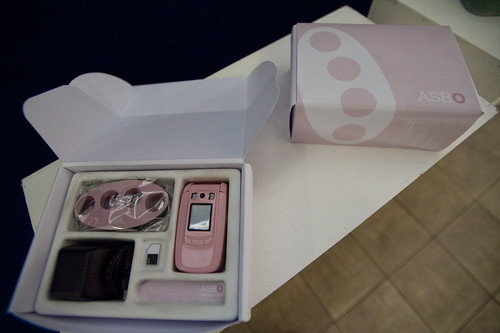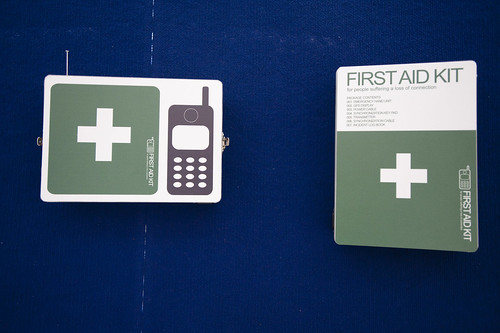
“This work examines approaches used in the development of technological product. It [aims to] raise awareness of what is unquestioned in our technologically mediated lives. Issues surrounding current approaches to the design of technological prduct are embodied offering design proposals for presentation and debate.
Design Proposal: The ASBO Range
In order to address these issues and raise debate to whether or not the integration of video into the mobile phone might facilitate violence a range of products has been developed. The ASBO range packages mobile phones with offensive weapons and is intended to develop an understanding of the role the phone plays in these acts.

“Driven by theoretical writings on the subject of technology and prominent social issues the designs are the result of a critical investigation into consequences surrounding use of technological products. New technological products have become accepted not only through their use but also through their rhetorical use of disclosure and marketing on and around them. These designs exist as a means to elicit perceptions and stimulate debate amongst student designers.”
Design Proposal: First Aid for People Suffering a Loss of Connection
Technology is becoming an extension of us. Will we need to treat a loss of connection as we would an injury? The first aid kit for people suffering loss of connection provides the means for the suffering user to synchronize lost technology with emergency devices. It offers access to all of your stored information and reconnects you.
Contexualising critical design was the title of a paper (I only heard the talk) by Matthew Malpass, a Ph.D. student in the School of Art and Design at Nottingham Trent University.
He also created for exhibition at the Design Connexity event, these objects — sort of physical research instantiations of his PhD research.
Matthew Malpass
Key words: Critical Design, Design Taxonomy, Classification, Practice
This research addresses critical design (Dunne 1998) attempting to classify critical design practices, defining the role they play in the field of product design. The research forms part of an ongoing PhD project exploring critical design and its contribution to product design. Over the past decade particular design practices have emerged which are intended to directly challenge the idea that the only objective for objects and the process of designing them is to service industry. These methods of practice are termed ‘critical design’. The term critical design was popularised in Anthony Dunne’s book Hertzian Tales. In it Dunne introduces the idea of product design and electronic objects fusing into critical design where the object functions as critique. Critical design has since been adopted as an umbrella term for any type of design practice which suggests that design offers possibilities beyond solving design problems. This adoption and generalisation of the term has created a problem with critical design in that it’s described as more of an attitude rather than a style or movement; a position rather than a method (Blauvelt 2003). There is no definitive process or criterion to establish what a critical design is or what role it plays in the field of product design. Objects of critical design are often one-off objects that find themselves displayed in gallery space, and there has been serious criticism from the traditionalist, human factors community, suggesting that because of the lack of utility and the context in which they exist, objects of critical design are seen at most as informative art pieces and not design objects. The research uses a radical hermeneutic approach to explore critical design in an attempt to classify and categorise the differences in practice and methods employed by critical designers. Classification takes the form of a taxonomy and maps critical design in an attempt to contextualise practices within the genre and the genre within the field of product design. The research considers the emergence of critical design as a reaction to ‘design orthodoxy’ (Form Follows Idea: An Introduction to Design Poetics
Ball & Naylor 2005) and the demand placed on designers by consumer society, exploring the shifting discipline of product design towards the interdisciplinary arena, and the need for today’s designers to draw inspiration and stimulation from other fields of expertise.
Why do I blog this? One of Matthew Malpass’ points in his talk (I do not have the paper, unfortunately I had to leave the large conference proceedings behind lest my luggage explode on my forward journeys) reflected upon the way that “critical design” in the Dunne & Raby mode had a particular community in which it is legible, mostly towards the art and art exhibition realm. It made me think that his taxonomy project, part of his PhD work, could provide a useful framework for talking about how design participates either as critique but also further on — as a way to change the world in material ways. The critical design approach offers very compelling reflections of existing practices, various social ailments, commentary on aspects of our world through design and designed objects. This is very important. At the same time, one has to be prepared to “read” these objects as such, which requires a particular critical eye — critical as in the kind of critique that art, theory and so on is able to do. This is something that is either learned, or developed and a skill that is not particularly widespread. So, in a much more quotidian context than a museum, gallery, or other “meta” culture setting, some critical design objects will appear as nonsense — as a waste of time, something that doesn’t get things done or doesn’t do as one expects. Sometimes that moment forces reflection. But, in the heady, hard-scrabble world where people just want to get from home to work and back, or have a pint at the local, or check their diminishing pension fund, these things get in the way of basic life-living.
So, what are the other approaches to remaking the world into something a little different from what we live today, and one that enrolls other people than just art fans and so forth? I don’t know — but I often look for signs that one has entered into these more everyday communities, like the comment on a gamer blog about the PSX project where the fans of games engaged in a curious conversation about the weird game controller we built and so in it both possibility and preposterousness. The object designed becomes the source of conversations. At first you see this allergic reaction in funny, awkward statements like — “stupidest fucking idea ever”, and despite the hilarious dismissal, you are entering into the community and evolving the concept not as an outsider but as a newbie, engaged in the larger conversations, perhaps turning stupid things into things that are informed by design and design strategies. (Leastways, that’s what I’m thinking..feel free to find what I am talking about as the stupidest fucking thing ever.)
(cf http://forums.maxconsole.net/showthread.php?t=117337)
(cf http://www.engadget.com/2008/07/11/ps2-controller-hack-simulates-fatigue-to-make-games-more-realist/)